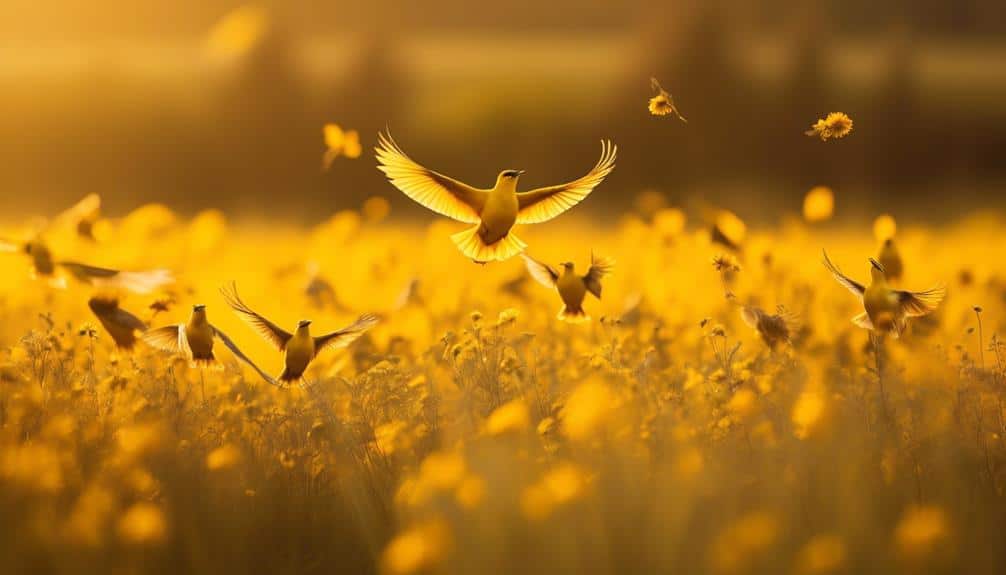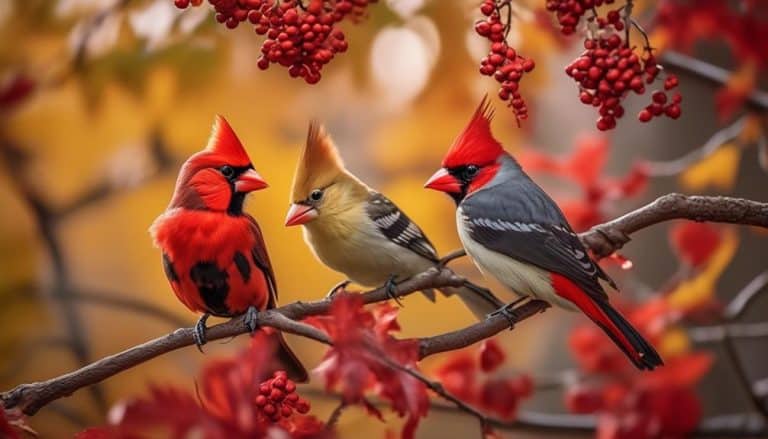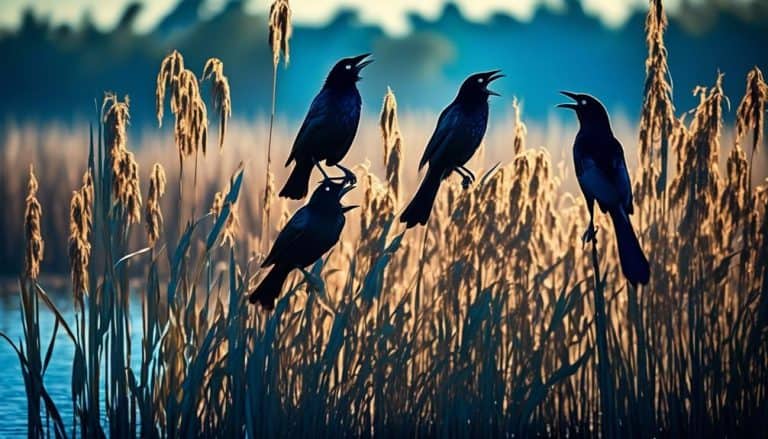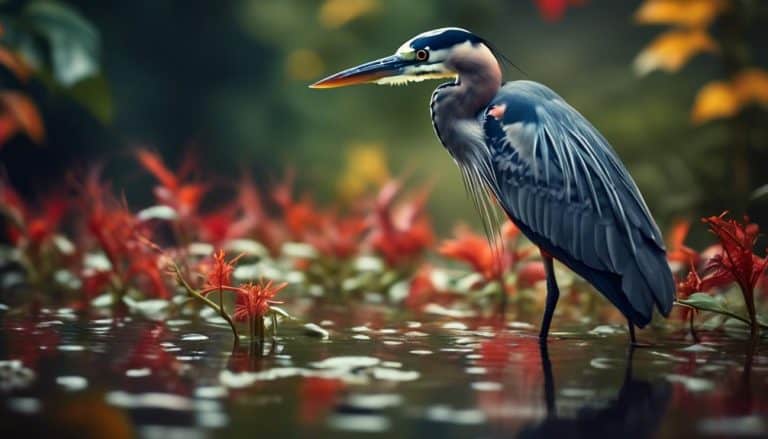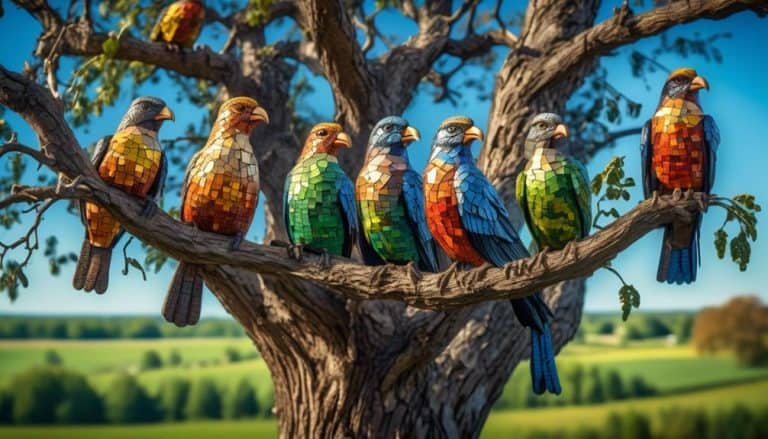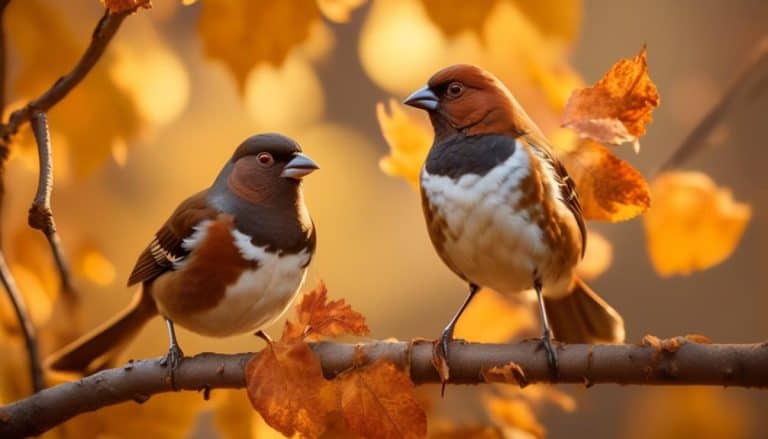As I sit here in the serene wilderness of Minnesota, I can't help but be captivated by the vibrant hues of the yellow birds that grace our land. These feathered creatures, with their cheerful melodies and bright plumage, add a splash of color to our otherwise green and brown surroundings.
But what is it about these yellow birds that make them so intriguing? Well, dear reader, let me take you on a journey to uncover the secrets and wonders of these captivating creatures.
Common Yellow Warbler
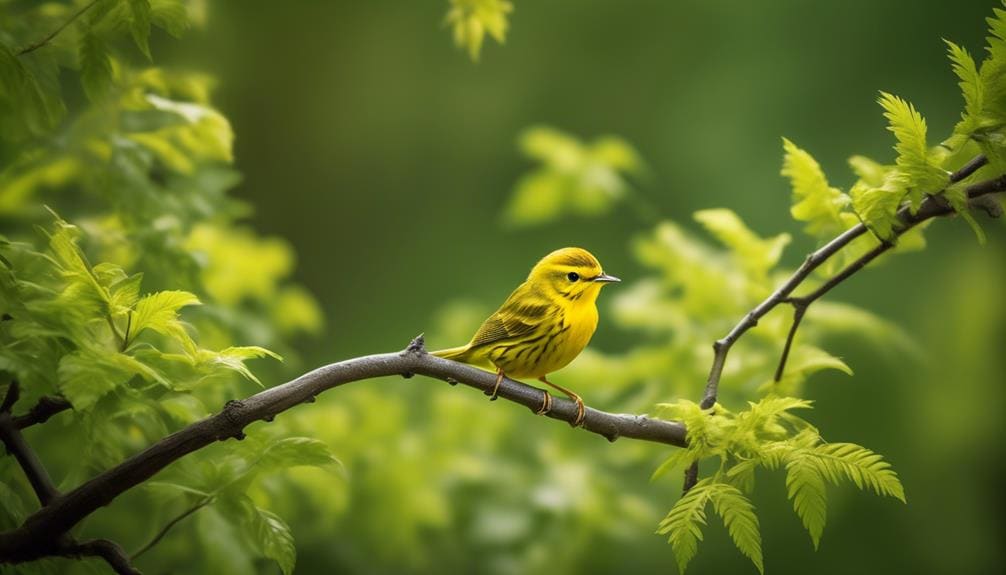
The Common Yellow Warbler is a small migratory songbird that can be found throughout Minnesota during the summer breeding season. This vibrant yellow bird is known for its distinctive song and can be easily identified by its yellow plumage and reddish streaks on its breast. The behavior patterns of the Common Yellow Warbler are fascinating to observe. They're highly active and constantly move through the trees, flitting their wings and foraging for insects. Their lively presence adds a delightful touch to the Minnesota landscape during the summer months.
When it comes to nesting habits, the Common Yellow Warbler is known for its skillful construction of cup-shaped nests. These nests are typically built in shrubs or small trees, often near water sources such as rivers or wetlands. The female warbler takes the lead in nest building, using materials such as grass, bark, and spider silk to create a secure and cozy home for their eggs. It's interesting to note that the female warbler often lines the nest with soft materials such as feathers or fur to provide extra insulation and comfort for the growing chicks.
American Goldfinch

Frequently seen in Minnesota, the American Goldfinch is a small, active songbird known for its bright yellow plumage and distinctive flight pattern. This species exhibits interesting migration patterns, with populations in the northern regions of Minnesota migrating further south during the winter months. These migrations are driven by the availability of food and the need to escape harsh winter conditions.
American Goldfinches are primarily granivorous, meaning they primarily feed on seeds. Their diet consists mainly of various plant seeds such as those from sunflowers, thistles, and dandelions. This specialized diet is reflected in their unique beak structure, with a sharp, conical beak that allows them to efficiently extract seeds from their tough husks. Additionally, American Goldfinches have been observed to feed on insects and occasionally consume small fruits and berries.
During the breeding season, they also incorporate protein-rich insects into their diet to provide essential nutrients for their growing offspring. The American Goldfinch's migration patterns and dietary preferences make it a fascinating species to study and observe in the diverse landscapes of Minnesota.
Yellow-rumped Warbler
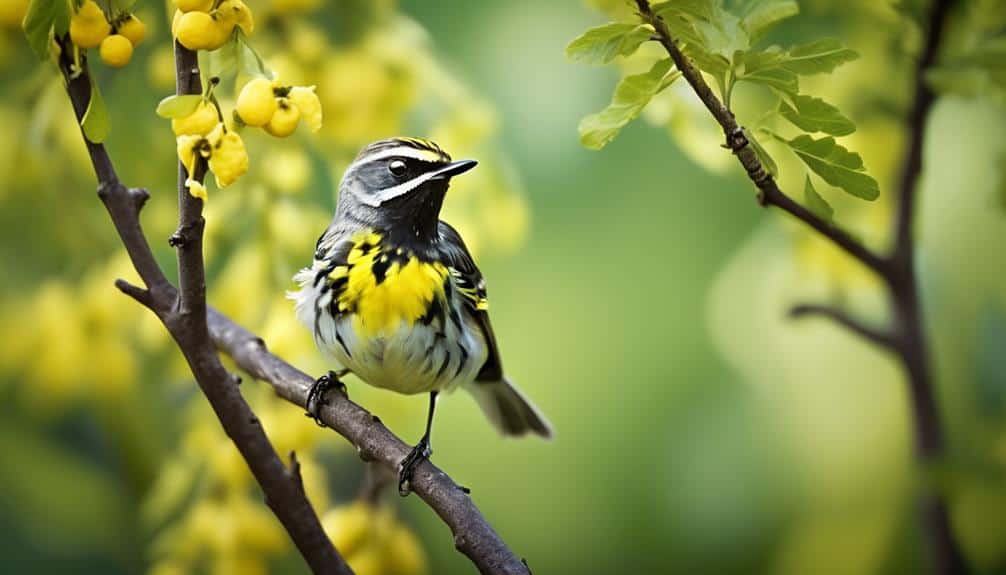
Often observed in the diverse landscapes of Minnesota, the Yellow-rumped Warbler is a small, energetic songbird known for its distinct yellow plumage and remarkable foraging abilities. This species is a common sight during the spring and fall migration periods, as they make their way to and from their breeding grounds in the northern boreal forests.
Here are some fascinating details about the yellow-rumped warbler's migration patterns and nesting habits:
- Migration Patterns:
- Yellow-rumped warblers undertake long-distance migrations, traveling thousands of miles each year.
- They're among the earliest spring migrants, arriving in Minnesota in late April or early May.
- During fall migration, they begin their journey southward in September, gradually moving towards their wintering grounds in the southern United States and Central America.
- Nesting Habits:
- Yellow-rumped warblers build their nests in coniferous and mixed forests, often high up in the canopy.
- The female constructs a cup-shaped nest using twigs, grasses, and bark strips, lining it with feathers and hair.
- They typically lay 4-5 eggs, which are incubated by both parents for about two weeks before hatching.
Yellow-bellied Sapsucker

As we shift our focus from the Yellow-rumped Warbler, let's now direct our attention to the Yellow-bellied Sapsucker, a fascinating woodpecker species found in Minnesota's diverse landscapes.
The yellow-bellied sapsucker, scientific name Sphyrapicus varius, is a medium-sized woodpecker with distinct yellow markings on its belly. This species is known for its unique behavior of drilling small holes in tree trunks to feed on sap, hence its name.
Yellow-bellied sapsuckers are migratory birds, spending their breeding season in the northern parts of the United States and Canada, including Minnesota. In the winter, they migrate to the southeastern United States, Mexico, and Central America. These migration patterns allow them to follow the availability of their preferred food sources and find suitable nesting habitats.
During their breeding season, yellow-bellied sapsuckers establish territories and engage in courtship displays. Males attract females by tapping on tree trunks to create a distinct drumming sound. Once a pair forms, they work together to excavate a cavity in a dead or partially dead tree for nesting. They're known to reuse the same cavity in subsequent years.
Eastern Meadowlark
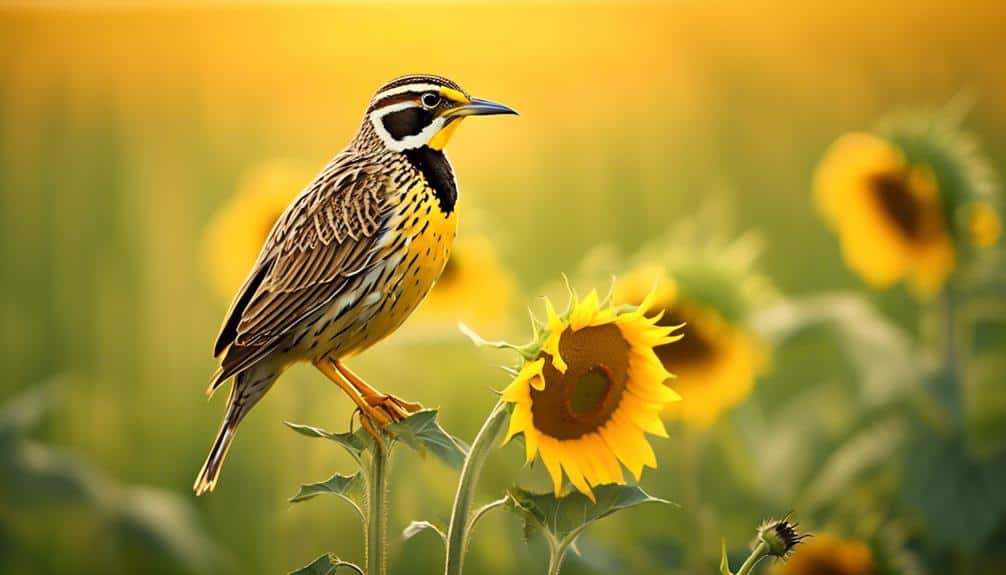
The Eastern Meadowlark, scientific name Sturnella magna, is a species of songbird commonly found in open grasslands and meadows throughout eastern North America. This beautiful bird has distinct features and behaviors that make it unique.
- Habitat and Behavior:
- Eastern Meadowlarks prefer habitats with tall grasses and scattered shrubs, such as prairies, pastures, and meadows.
- They're known for their melodious songs, which consist of a series of clear, flute-like notes.
- These birds are ground-nesters, building their nests in grassy areas and lining them with fine grasses and feathers.
- Eastern Meadowlarks feed on insects, spiders, and seeds, and they forage by walking or running on the ground, occasionally probing the soil with their bills.
- Conservation Efforts:
- The Eastern Meadowlark population has been declining due to habitat loss, especially from the conversion of grasslands to agricultural fields.
- Conservation efforts focus on preserving and restoring grassland habitats, such as implementing sustainable grazing practices and protecting critical nesting areas.
- Collaborative initiatives between landowners, conservation organizations, and government agencies strive to enhance habitat connectivity and promote the conservation of this species.
- Population Trends:
- The Eastern Meadowlark population has experienced significant declines in recent decades.
- Factors contributing to this decline include habitat fragmentation, pesticide use, and changes in agricultural practices.
- Monitoring programs and research studies help scientists understand population trends and develop effective conservation strategies to protect this majestic bird.
Yellow Warbler
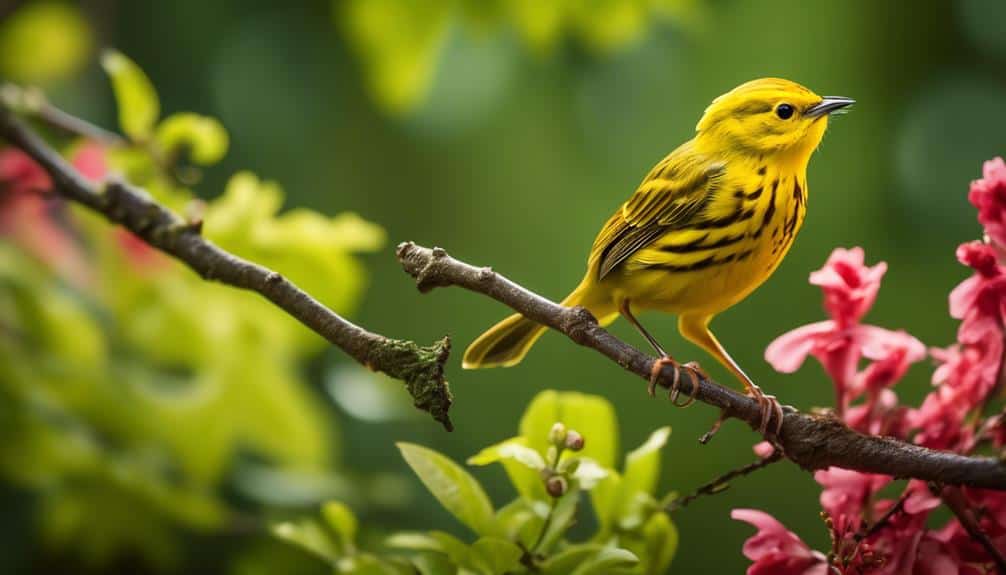
With its vibrant yellow plumage and distinct song, the Yellow Warbler, scientifically known as Setophaga petechia, is a small migratory songbird that adds a splash of color to the grasslands and meadows of eastern North America. As a passionate bird enthusiast, I find the Yellow Warbler's migration patterns and breeding habits particularly fascinating.
Yellow warblers have an extensive breeding range that spans from Alaska and Canada to Central America. They typically arrive in their breeding grounds around late April to early May, signaling the arrival of spring. These birds have a strong fidelity to their breeding sites, often returning to the same location year after year to raise their young.
During the breeding season, male Yellow Warblers are known for their beautiful songs, which they use to establish territories and attract mates. The females build their nests in shrubs or trees, skillfully weaving grass, bark, and spiderwebs together to create a sturdy structure. The nests are often hidden among foliage, providing protection from predators.
As summer turns to fall, Yellow Warblers undertake an impressive migration journey. They travel south to their wintering grounds in Mexico, Central America, and the Caribbean. These tiny birds navigate long distances, relying on their innate sense of direction and environmental cues such as the position of the sun and stars.
In conclusion, the Yellow Warbler's migration patterns and breeding habits are a testament to their adaptability and resilience. These small songbirds bring joy and wonder to the landscapes they inhabit, and their vibrant presence serves as a reminder of the diverse avian life that graces eastern North America.
| Yellow Warbler Migration Patterns | Yellow Warbler Breeding Habits |
|---|---|
| – Breeds across North America | – Arrives in breeding grounds in late April to early May |
| – Migrates to Mexico, Central America, and the Caribbean for winter | – Males use their songs to establish territories and attract mates |
| – Relies on innate sense of direction and environmental cues for migration | – Females build nests in shrubs or trees using grass, bark, and spiderwebs |
| – Fidelity to breeding sites, often returning to the same location | – Nests hidden among foliage for protection from predators |
Frequently Asked Questions
What Is the Average Lifespan of Yellow Birds in Minnesota?
The average lifespan of yellow birds in Minnesota varies depending on factors such as predation, disease, and habitat quality. Understanding their migration patterns can provide valuable insights into their survival rates.
Are Yellow Birds in Minnesota Migratory or Do They Stay Year-Round?
Yellow birds in Minnesota exhibit migratory behavior, influenced by factors such as food availability and weather conditions. Conservation efforts are in place to protect their population and ensure their year-round presence through habitat preservation and monitoring programs.
Do Yellow Birds in Minnesota Have Any Predators?
Yellow birds in Minnesota face a variety of predators. From hawks and owls in the sky to snakes and cats on the ground, these predators pose a threat to the yellow bird population.
What Is the Primary Diet of Yellow Birds in Minnesota?
The primary diet of yellow birds in Minnesota varies depending on their habitat preference. They consume a wide range of insects, seeds, fruits, and nectar, which provides them with the necessary nutrients for survival.
Are Yellow Birds in Minnesota Known to Build Their Nests in Specific Locations?
Yes, yellow birds in Minnesota are known to build their nests in specific locations. Their nesting habits are influenced by factors such as availability of food, habitat suitability, and protection from predators.
Conclusion
As I observe the yellow birds in Minnesota, I'm reminded of the vibrant tapestry of life that surrounds us. These winged creatures, with their bright plumage, symbolize the resilience and beauty of nature.
From the Common Yellow Warbler's melodious song to the intricate patterns on the Yellow-rumped Warbler's feathers, each species holds a unique place in this delicate ecosystem.
It's through the study and appreciation of these birds that we gain a deeper understanding of our natural world and our place within it.

